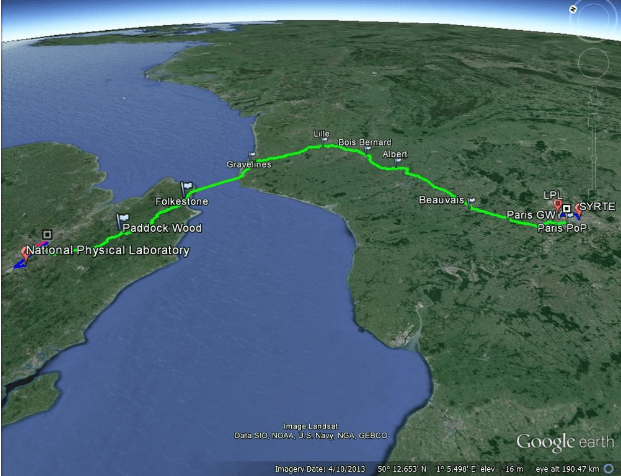Sep 9 2016
The National Physical Laboratory (NPL), in collaboration with LPL (CNRS, Université Paris 13) and LNE-SYRTE (CNRS, Observatoire de Paris and UPMC), has established a fully-functional fibre link between optical clocks based in the UK and France. The international fibre link, only the second of its kind in the world, will allow for the characterisation and comparison of optical clocks developed independently in the two countries, and will be used to help change the way we measure the second, the fundamental unit of time.
 The geography of the Paris-London fibre link
The geography of the Paris-London fibre link
As part of the International Clock Comparisons via Optical Fibre (ICOF) project run by GÉANT and funded by the European Union through its 7th Framework Programme, NPL, LPL and LNE-SYRTE have established an international optical fibre between London and Paris in collaboration with other National Measurement Institutes, such as INRiM in Italy and the Physikalisch-Technische Bundesanstalt in Germany. The 800 km long fibre passes through the Channel Tunnel with signal amplifiers at 10 stations along its length.
The link between Paris and the UK has been taken into service, meaning signals from a strontium optical lattice clock housed at NPL can be compared against signals from similar optical clocks housed in Paris. These comparisons are vital for ensuring that each clock is working correctly. NPL is also part of a new European research initiative, OFTEN, which aims to use fibre links for regular optical clock comparisons.
Optical clocks are the most accurate clocks in the world, losing no more than one second in the age of the Universe, 13.8 billion years. As they are the world's most accurate time-keeping devices, the only way to ensure that they are working is by comparison against other clocks of similar accuracy. Though comparison is possible on a local level, it is susceptible to local errors: if each clock were subject to exactly the same malfunction due to its location, it would not be possible to detect the defect locally. Thus, the wider the net of clocks, the more likely any discrepancy is to be detected.
Optical clocks are expected to lead to the redefinition of the second, the fundamental unit of time. The second is currently defined by the microwave resonance frequency of caesium atoms. This is less stable and accurate than a definition based on the frequency of visible light, which optical clocks can provide. A redefinition of the second in this way will allow for better timekeeping across the world, which is less subject to fluctuation.
Jochen Kronjaeger, a research scientist in the Time & Frequency Group at NPL, said: "The completion of the link is promising for the future comparison of these optical clocks across Europe. We look forward to future collaborative work through the OFTEN project and others."
For further information about the OFTEN project and the London-Paris fibre, contact Jochen Kronjaeger